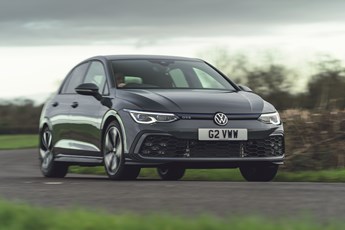
The start point for the best source of fleet information |
First drive: Volkswagen Golf GTE
Date: 27 January 2021 | Author: Sean Keywood

|
|
||||||||||||||||
Think plug-in hybrids are all about efficiency at the expense of driving pleasure? Well, that's not the approach Volkswagen has taken with its new Golf. There's only one PHEV in the UK range and this is it - a full-blown hot hatch that shares almost everything with the latest incarnation of the iconic GTI, from the exterior's honeycomb front air intake and roof spoiler to the interior's sport seats and stainless-steel pedals. It's not just the looks either - the power outputs are also identical, though the GTE gets its 245hp by pairing a 1.4-litre petrol engine with a 110hp electric motor.
It's this powertrain that brings the GTE on to more familiar eco-car territory. Switch on the ignition, and it automatically starts in pure electric mode. Running on the battery alone, it can cover up to 40 miles on the WLTP cycle, while the motor provides more than adequate power on its own for all regular driving conditions, including motorways. The petrol engine will kick in if the accelerator is floored, but otherwise a GTE driver who kept the battery topped up could complete short journeys for months without ever needing to use it.
Alternatively, selecting one of the other hybrid drive modes, or just waiting for the battery to run low, will bring the engine back into the picture. There's useful flexibility here - for instance, the system can be adjusted by the driver to prioritise recharging the battery, or to send more power from the battery to the wheels, with various levels either way to choose from. The level of regenerative braking on offer is also selectable and, in a clever feature, the powertrain is also automatically adjusted based on GPS and sat-nav data.
Opt for sport mode, deploy as much power as possible, and the GTE doesn't disgrace its performance car roots. As well as the GTI's looks, the GTE also retains its sporty chassis set-up, and although the weight of the battery (the car overall is 161kg heavier) does a bit to dampen the expected hot hatch feeling of sharpness and agility, the GTE is still fun to drive. The optional adaptive suspension fitted to our test car keeps it nicely flat when cornering on the sportiest settings (ride quality is good the rest of the time), the standard electronic differential lock and computer-controlled vehicle dynamics manager work well to limit understeer, and there's crisp steering. In addition, the GTE gets closer than you might imagine to the GTI's straight-line performance, as the extra weight is partly compensated for by increased torque.
In terms of practicality, the main area where the GTE loses out is the size of the boot, which is 101 litres smaller than regular Golfs to accommodate the battery. The rest of the interior is the same, though that's not all good news, as the standard of trim, while solid enough, doesn't feel like the cut above the mainstream you would expect from VW, and the touchscreen infotainment system feels overly complicated, with awkward touch sliders controlling simple functions like stereo volume and cabin temperature.
It is perhaps a shame that the only plug-in hybrid Golf you can buy in the UK is a range-topping hot hatch, which doesn't seem like the most obvious company car choice. A less powerful, 204hp PHEV Golf is sold in Germany, but VW says there are no plans to bring it to the UK. However, this powertrain is sold in the UK with the Golf's VW Group cousins the Skoda Octavia, Seat Leon and Audi A3, and all these models are cheaper to buy and more economical than the GTE. Of course, the GTE is still superbly economical if plugged in regularly and still offers the usual terrific PHEV BIK tax benefits. It makes a compelling case, therefore, for the user-chooser hot hatch fan. But for those who don't need its ultimate performance, those other models will be worth a look, as will the Mercedes-Benz A 250e, which is also cheaper and has a bigger battery.
Volkswagen Golf GTE
P11D: £35,955
Residual value: 38.9%
Depreciation: £21,954
Fuel: £1,215
Service, maintenance and repair: £2,335
Cost per mile: 42.50p
Fuel consumption: 256.8mpg
CO2 (BIK band): 26g/km (7%)
BIK 20/40% a month: £42/£84
Boot space: 273 litres
Engine size/power: 1,375cc/150 hp with 110hp electric motor
Verdict |
8/10 |
|||
 |
|
 |
|
|










